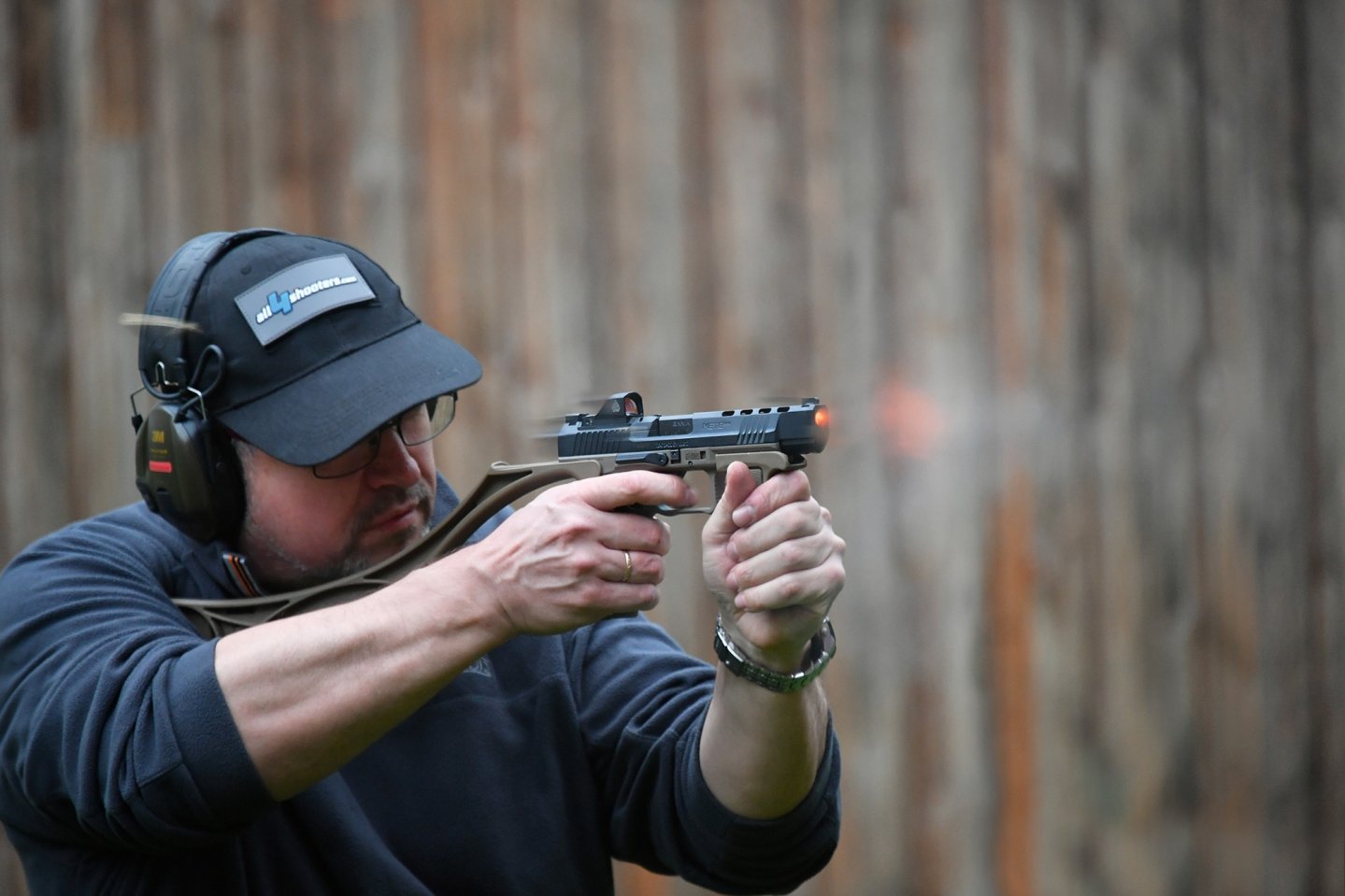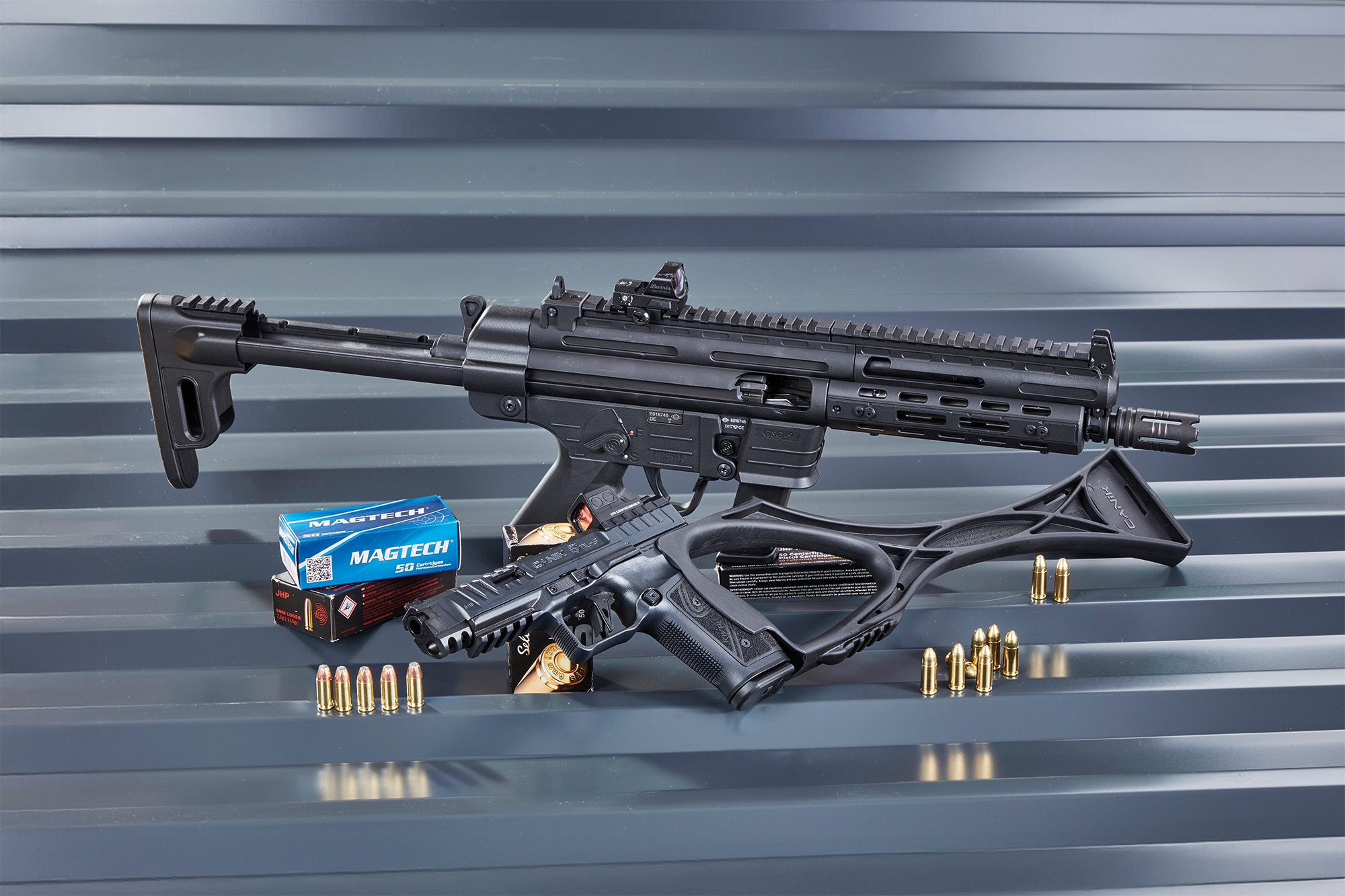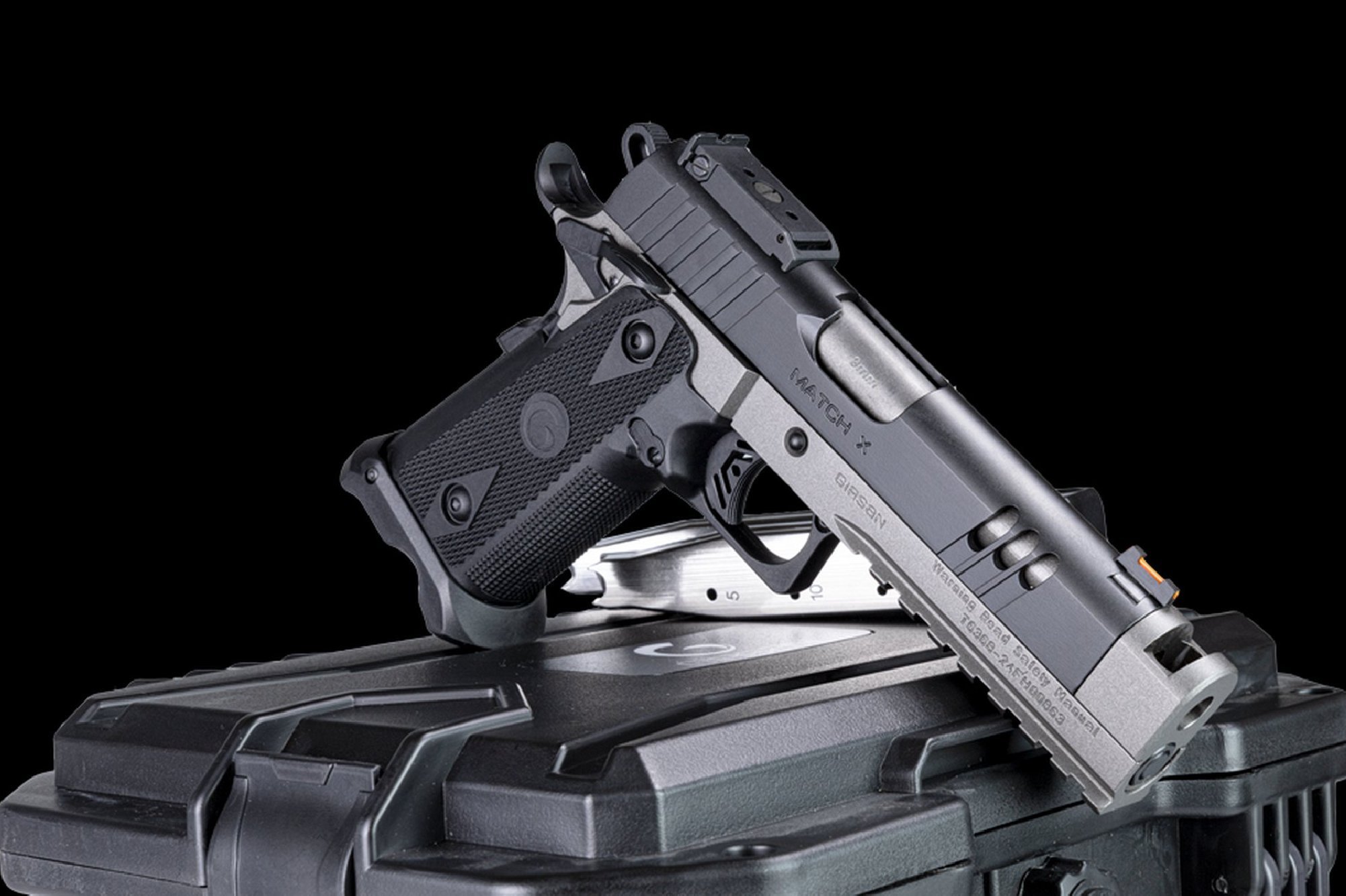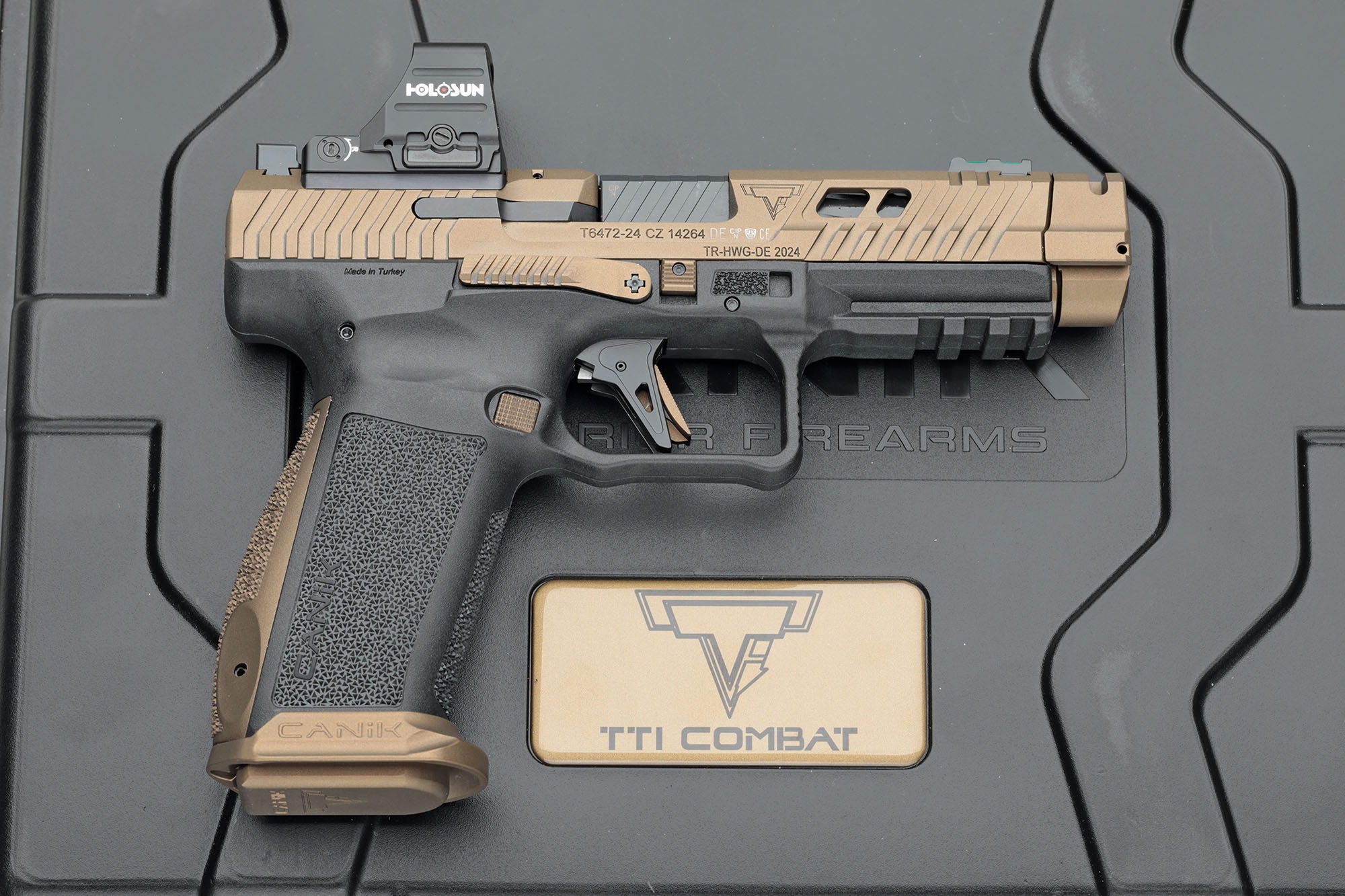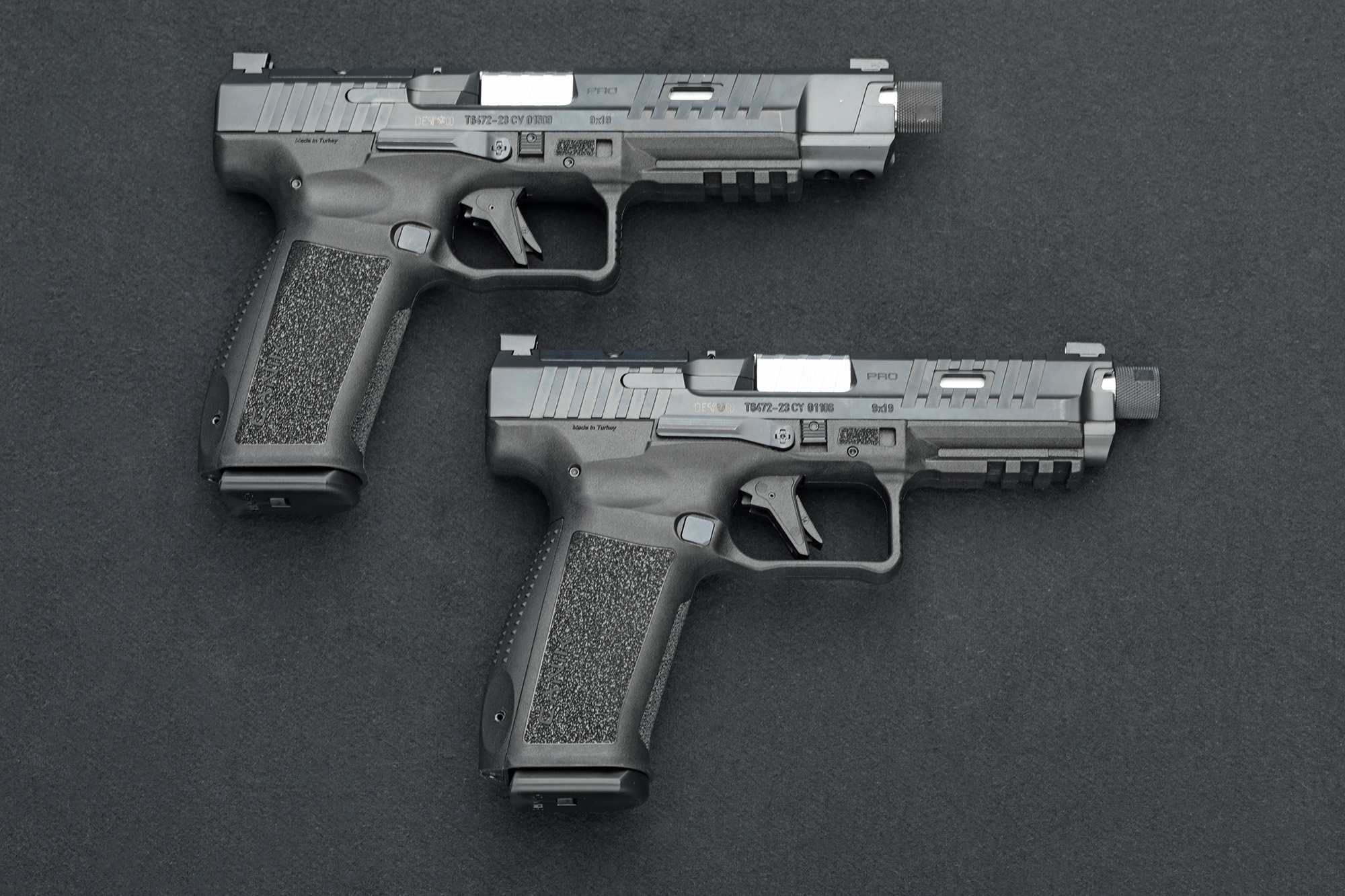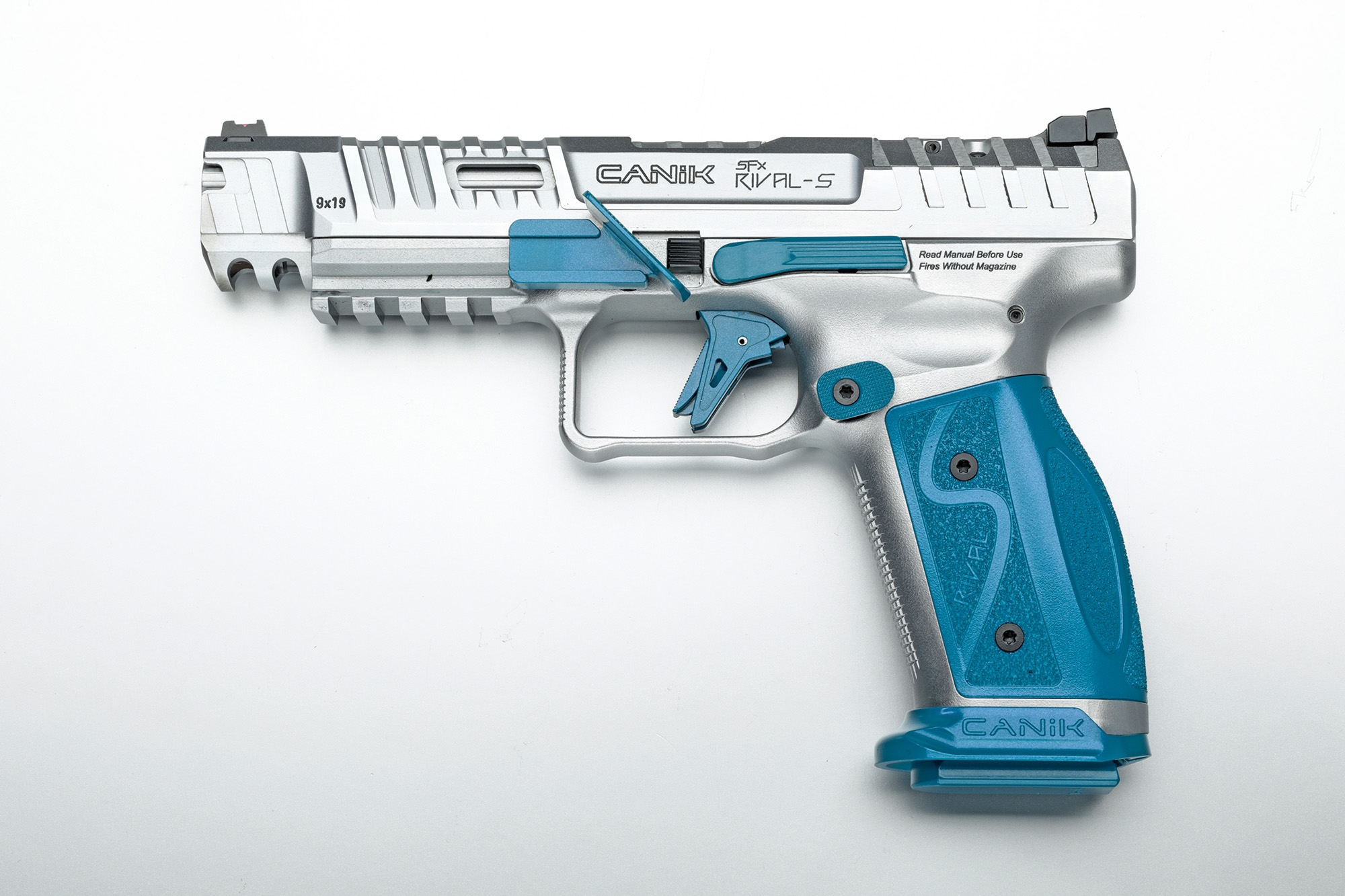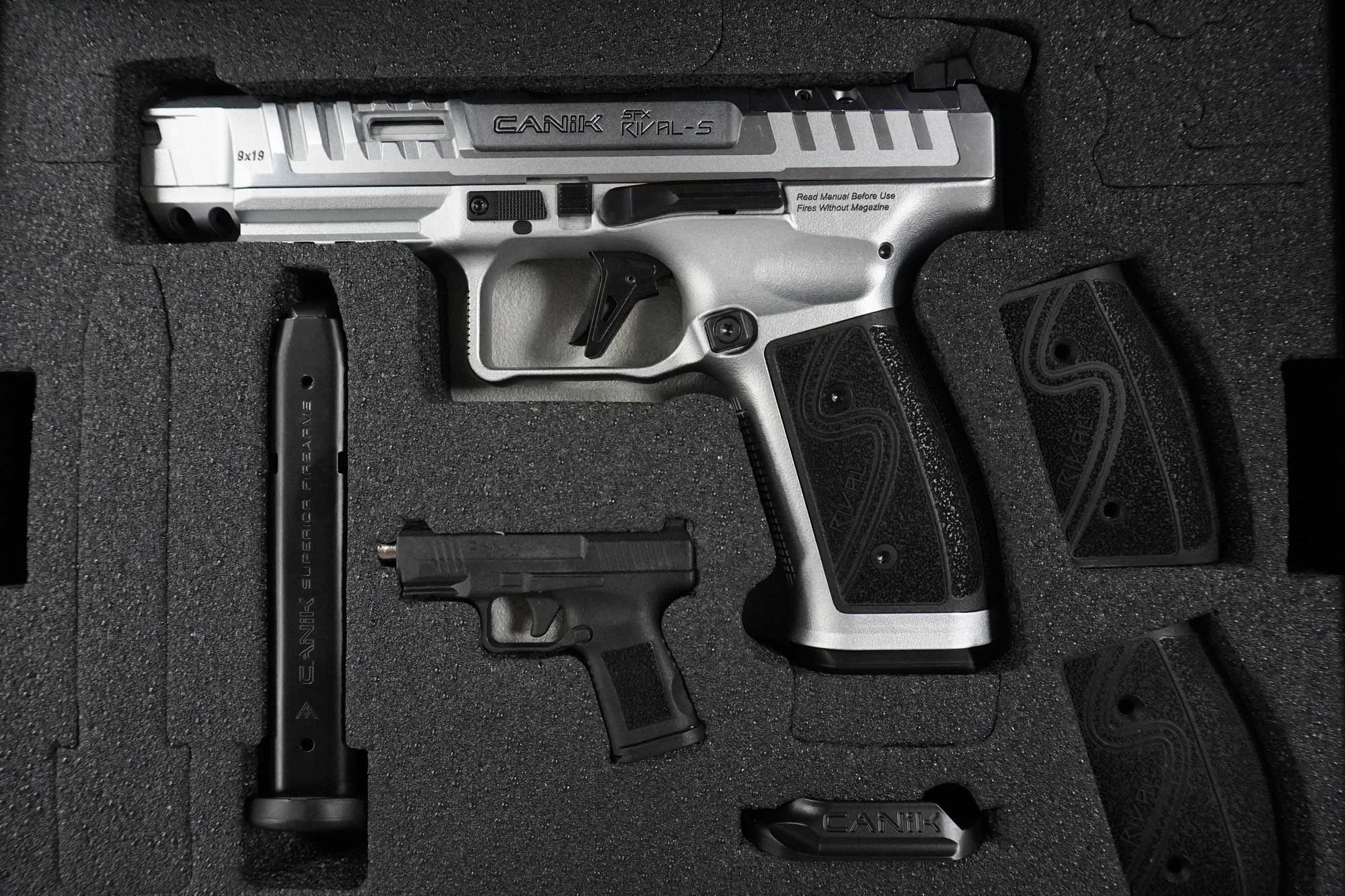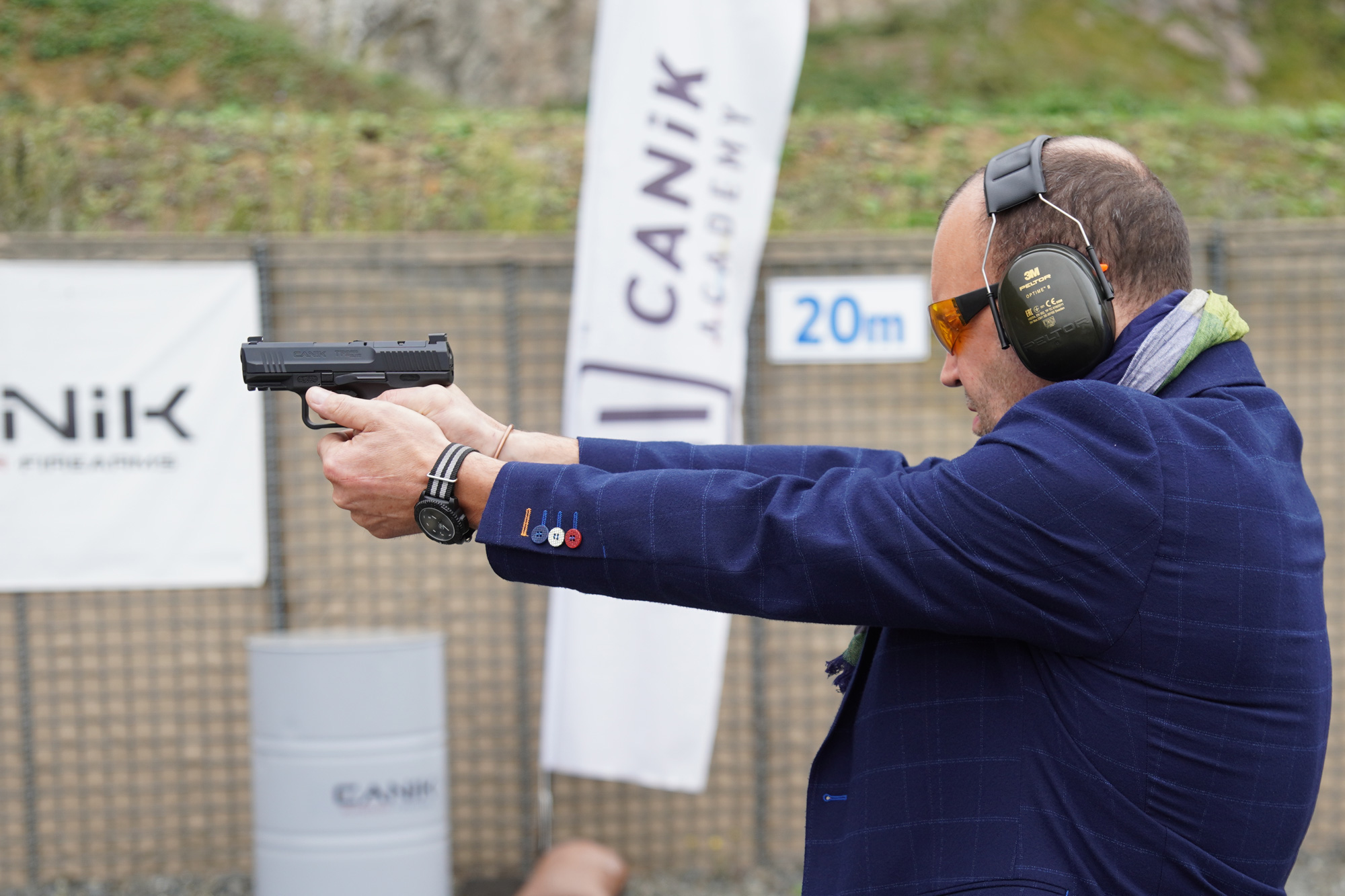Canik pistols from Turkey have made a name for themselves in terms of quality and value for money. Therefore, we have taken a closer look at the still fairly new Canik METE SFT and SFX models in 9mm Luger. After opening the relatively large pistol cases, the first thing that catches your eye is the matching color holsters that hold the Canik METE SFX or the somewhat shorter SFT. The abbreviations FDE, for Flat Dark Earth – the beige-brown color of the frame – and OR, for the Optics Ready slide cutout which can accommodate a red dot sight, are still missing from the full designation of the two test guns. But these are more subtleties that will be noticed later. Because after the wondering about the holstered pistols is over, you realize that the pistol case has a multi-layer design. Under the lid, on which the envelope of the instruction manual is stuck, there are more accessories. Immediately, you reach for a small pistol model. No, this is (unfortunately) not a toy gun for the offspring. It rattles inside, which signals some contents. The contents are hidden in the grip of the pistol miniature. Its "magazine base" can be slid, and a few high-quality-looking bits and screws tumble out. The bits fit into the "muzzle" of the pistol miniature that serves as a handle. The screws are for mounting the red dot sights provided for the Canik METE models. The necessary adapter plates are also already included, but more of that later.
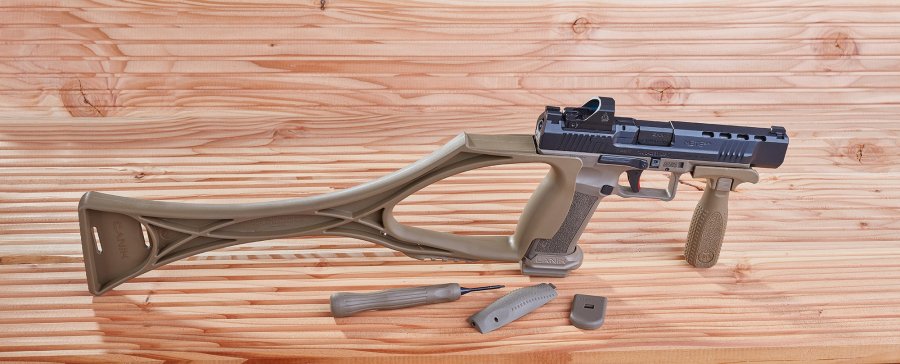
Canik METE SFT and SFX with many accessories in a practical case
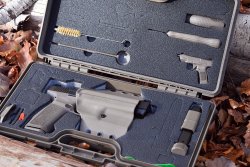
If the "bit gun" looks a bit playful, the more than ten-centimeter-long handle of the pin punch above it signals that this tool can handle a lot of use. The punch is needed to drive out the dowel pin that holds the back of the handle. An interchangeable backstrap is part of the factory equipment. The mini gun, the T10 Torx bit and the matching screw are needed to mount the magwell – which is also included – in its place on the grip. At the latest when handling, you will notice that the magwell is made of anodized aluminum in a matching color. Since Canik does not use plastic for the magazines, but sheet steel, this is definitely a better choice. Thus, even after frequent quick changes, the magwell entrance remains smooth and without scratches. The magazine funnel is quite suitable when changing to the replacement magazine, as this is equipped with a larger (hollow) base. Thus it holds 20 instead of 18 cartridges. The latter are much easier to load with the, yes, again, included loading aid. Canik uses Mec.Gar magazines, more a sign of common sense than incompetence. Because this leading magazine manufacturer understood more than fifty years ago why most malfunctions in semi-automatic firearms originate from the magazine, and draws its consequences with a correspondingly reliable production.
Canik offers its own red dot sights under the brand Mecanik
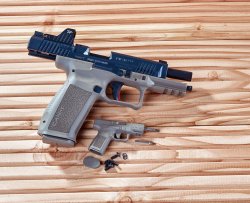
Canik offers its own line of red dot sights under the Mecanik trade name. Only one of the small series of Mecanik sights fits our test pistols, the MO1 model, a so-called Micro Red Dot Sight (MRDS) with a 3-MOA dot. The sight requires an adapter plate (included) for mounting. This brings us to the accessories that require an additional charge. The Mecanik MO1 costs 269 euro. It was mounted by us on the METE SFT.
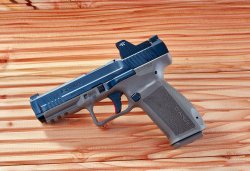
Similarly daintily manufactured, and at 270 euro almost at the same price, came the brand new Mini Micro OT-RDM16 red dot sight from UTG on the slightly longer METE SFX. Also this model relies on a 3-MOA dot. Both MRDS's low profile allows co-witnessing if the red dot fails. When zeroing, the red dot can already be lined up with the front sight twilight dot. This means that, depending on the load, there are usually only minor elevation adjustments to be made, while windage is always correct. The lens of the Mecanik MO1 is about two millimeters higher than that of the reflex sight from UTG, with almost the same width. Otherwise, both function similarly, and have neither on/off switches or manual brightness settings.
The advantages of Canik Mete SFX and SFT
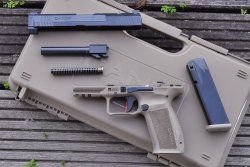
There is a biting saying that a lot of accessories are usually offered with products that are poor in features. This may often be true, but it does not apply to Canik pistols. Once you swap the magazine release, you have a full-featured pistol that is both right- and left-handed. The slide stop, like the takedown lever, is also ambidextrous. The ergonomics of the grip are convincing, and the entire gun appears to be of high quality and tidy in the interplay of its parts, i.e. not burdened with design nonsense. Aesthetes will grumble about a visible cast seam on the grip section. But that's all, and since there is nothing else to complain about, this article lacks plus/minus boxes. As for the Canik trigger, here are the result in numbers: between 1,900 and 2,000 grams, then it breaks. A very low value for a striker-fired gun. And then there are the characteristics: hardly anything is missing from the much-cited "match trigger". The exceptionally well-defined wall is one of the best we've ever had in our hands or on our index finger with this type of pistol from the factory. Clearly defined, virtually no scratching, and the shot is already gone. Muscle as well as neuronal memory of our older team members recalled the brilliant trigger release characteristics of a Heckler & Koch P7M8 or P7M13, but without the pre-shot squeezing of the HK grip cocking mechanism. As soon as the trigger of the Canik is released,the firing pin, which is also a cocking indicator and slightly protrudes from the back, disappears from its funnel-shaped socket at the slide end. Visually and haptically, this safety feature is as easy to perceive as an additional indicator showing whether a cartridge is in the chamber. The loaded chamber indicator is located on the slide's top. It is therefore a separate safety device that is mounted independently of the extractor claw on the right side, which is often used for this function. An invisible, but all the more important safety feature of the Canik becomes apparent during disassembly. The slide is pulled back only a few millimeters for disassembly. When the disassembly lever is then depressed, a slight push forward is sufficient and the slide slides off the frame. Neither the gun is cocked, nor does the finger have to pull the trigger.
Test: the 9mm Canik METE SFT and SFX on the shooting range
Far below, in a specially designated corner of the safe, there they lie: the sometimes not inconsiderable remains of ammunition long since no longer on the market. Old Surplus cartridges in 9mm Luger from Barnaul – still with steel cases – or the very inexpensive rounds from Sellier & Bellot, which were also popular a long time ago. The ones with the "extra hard" primer brushed over in rich red – they all ignited, even with a deliberately careful trigger squeeze. The Caniks obviously ignite even harder primers that are considered troublesome. If a stock is available, the pistols should also be tested at a somewhat longer distance. Fifty meters is actually the firing distance for associations that offer disciplines for pistol caliber carbines. However, the top trigger characteristics of the Canik seemed more appropriate for that than the 25 meters range. The Canik METE TP9 SFX's ergonomics resulting from the stock allowed for a somewhat compressed, but still adequately supported position from a rifle rest. Shot with the red dot, most loads even held the ten ring of the ISSF precision target. Quite contrary to expectations, the stock did not "slipped” to the side even when pulled in a bit tighter. The whole thing, which can be attached in no time at all, seemed quite confidence-inspiringly stable. Malfunctions or abnormalities? Not a trace of them.
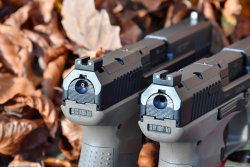
At 25 meters, the Canik METE TP9 SFT was used. But without a stock, and inserted into a Heymann guntester. Apart from some impressive individual results, the mean value of the groupings – only 35 millimeters – speaks for itself. Since the tests were done with the same types of ammunition, there was one more finding: about two centimeters difference in barrel length hardly makes a difference in terms of muzzle velocity. The larger average group at 50 meters is probably due less to the combination of gun and ammunition than to the non-manually dimmable red dot brightness of the two test sights. Their automatic system equates the ambient light acting on the sensor with the brightness value in the target area. But this is rarely the same on closed shooting ranges, so both sights tended to over-illuminate. At 25 meters, however, these effects were barely noticeable. Both reflex sights have a 3-MOA dot. Like a normal reticle, the illuminated dot covers part of the target. The target covered area up to 50 meters still is a little less than 50 mm, at 100 meters it is already a little more than 100 mm. So if you want to shoot farther than 25 meters with a red dot sight and hit a small target accurately, you should definitely stick with small dot sizes. Reflex sights offered for quick shots at short ranges have dot sizes of 6 or 7 MOA, which obscures more than 10 centimeters at 50 meters. When fired freehand without a stock, there was no noticeable difference between the two models.
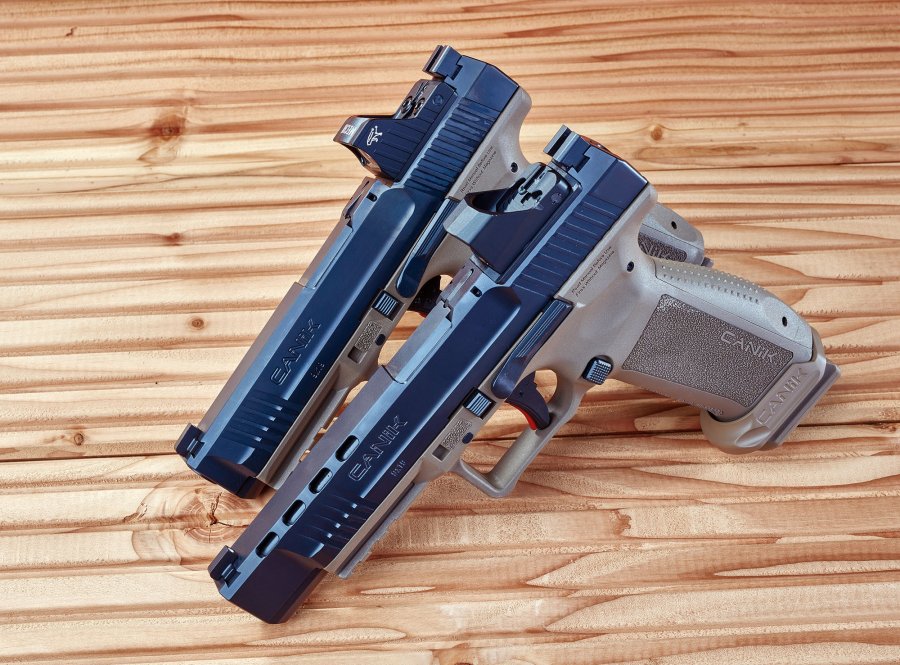
Canik METE SFT and SFX specs and prices
| Model | Canik METE SFT FDE OR | Canik METE SFX FDE OR |
| Price
(RRP in Germany): | 699 euro | 799 euro |
| Caliber: | 9mm Luger | 9mm Luger |
| Magazine
Capacity: | 18-20
rounds | 18-20
rounds |
| Dimensions
(LxWxH): | 192x36x146
mm | 211x36x146
mm |
| Barrel
Length: | 144 mm | 132 mm |
| Twist
Length: | 250 mm | 250 mm |
| Trigger
Pull Weight: | 1,900 g
approx. | 1,900 g
approx. |
| Trigger
Pull Weight: | 790 g
approx. | 835 g
approx. |
| Equipment: | OR slide,
spare magazine (20 rounds), loading aid, holster, magazine funnel,
interchangeable backstrap, adapter plate for red dot sight, high-quality tools,
cleaning kit, hard case. | OR slide,
spare magazine (20 rounds), loading aid, holster, magazine funnel,
interchangeable backstrap, adapter plate for red dot sight, high-quality tools,
cleaning kit, hard case. |
Our test conclusion on the Canik METE SFX and SFT
They will have a hard time. Not the ones from Canik, but other similar products. Canik manufactures top quality, technically improved guns in many respects, and these with accessories that will probably be unparalleled for such prices for a long time. Those who think that those who come later can just take a leaf out of the book are partly right. But Canik has not only copied. Canik pays license fees to Wilhelm Bubits for the grip frame, for example. And to copy something, but then to improve it and market it at such prices, is a clear message to the established manufacturers.
You can find out more about the METE series guns on this English-language website from manufacturer Canik.


